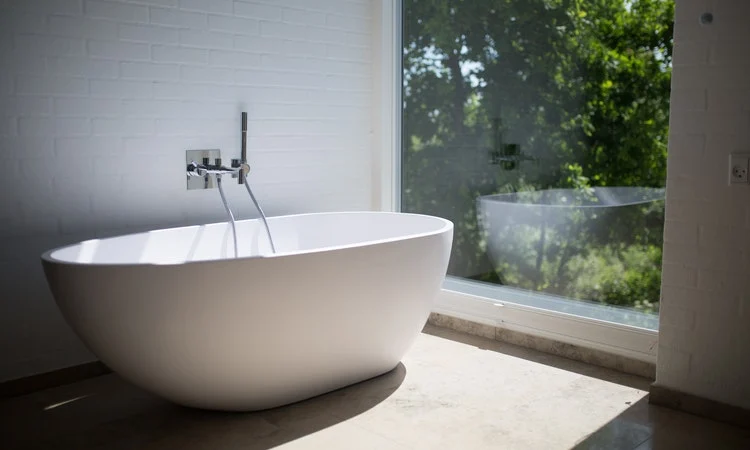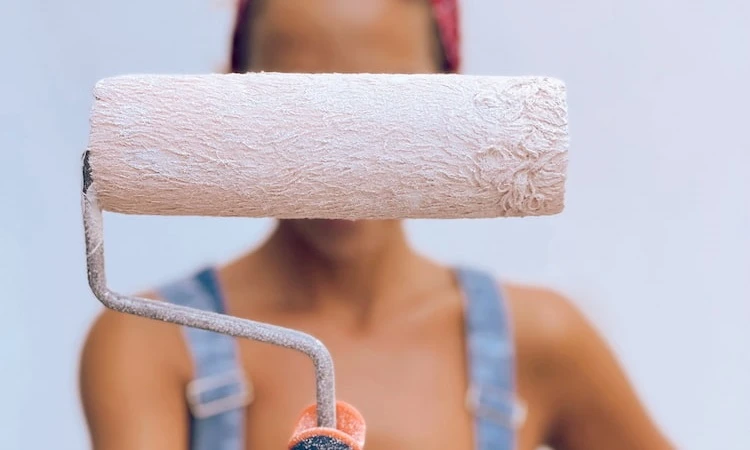Like everything else, your fiberglass bathtub will age and look ugly. The finish will wear out as it gets old, and stains will build up.
You will think about painting it over to improve its look. But the question is: Can you paint a fiberglass tub?
Painting a fiberglass bathtub is not good because of adhesion issues; the paint is likely to peel. However, if painting the tub is the only option, some methods help ensure the paint’s adhesion to the glass.
These methods involve sanding the surface and using high-quality epoxy paint.
Latex/acrylic paints are the most appropriate to use as they adhere well to fiberglass. They are also crack and blister-proof, and they don’t easily peel.
Continue reading because I will provide more relevant information and a step-by-step process on how you can proceed with your bathtub painting project.

How to Tell if a Bathtub is Fiberglass or Acrylic?
There are different materials that bathtub manufacturers use.
These include fiberglass, acrylic, porcelain, ceramic, cast iron, cultured marble, copper, etc.
However, the most common are the first two, which look almost the same. Let me discuss their differences below to help you determine which is which.
Fiberglass Bathtub
Fiberglass bathtubs are usually thicker than acrylic. The simple hack of confirming that the tub is Fiberglass is to check the edges.
If they are thick, it could mean that it is fiberglass. Another thing to consider is the color. The color of these tubs is usually white.
The finish of a fiberglass tub is rough. Aside from the rugged feel, these tubs are also colder than acrylic. The fiber material is lighter than acrylic (roughly a 30%) in weight.
Additionally, you can apply pressure on the tub to check the flexibility of the fiber.
Acrylic Bathtub
Acrylic bathtubs usually come in a smooth finish. They also have several color options compared to commonly white fiberglass tubs.
As mentioned, acrylic tubs feature thinner edges. In other words, it is the exact opposite.
Acrylic tubs are more expensive than fiberglass. What makes the price difference is the durability. The former is generally stronger.
It doesn’t damage easily, and it can handle impact and weight better than the latter.
If you are purchasing a new tub and are unsure of the material, get help from the store attendants. They should know their products and tell you if they are fiberglass or acrylic.
Can You Paint a Fiberglass Bathtub?
For sure, you can. But it is not a question of “can you paint.” The real question is: Will it work? Of course, painting a fiberglass bathtub is not impossible.
However, it can be taxing and messy as it requires sanding to ensure that the paint will adhere to the surface.
Consider many things if you decide to paint your fiberglass bathtub. Ask yourself. Who will do it? Can you do it yourself, or do you need someone?
Do you know how to proceed with the project? Is it more economical? Does it involve health risks?
If you figure painting your bathtub is the best choice, you can proceed with the project. To ensure that the paint adheres to the fiber surface, scuff sand the surface with 220 grit sandpaper.
Then wash it with acetone to ensure that no fiber dust is left.
You also need to ensure that you are doing your project in a properly ventilated area. If it is a free-standing tub, bring it out and do the process outside.
Contact with fiber dust may cause skin, eyes, nose, and throat irritations. In short, you must observe proper precautions.
I will provide a detailed discussion on what paint to use in the succeeding sections of this article.
I will also detail the steps you can use as a general guide if you decide to paint your fiberglass tub yourself.
Do You Need to Prime Your Fiberglass Tub Before Painting?
Generally, you may not need a primer when painting your fiberglass bathtub as the surface is already smooth.
However, any primed surfaces do better than those that aren’t. It allows the paint to adhere well to the surface and reduces peeling.
The paint that you intend to use may also require a primer. Therefore, read the paint label carefully, as it may not work without a primer.
You are likely to use acrylic paints, and most of them require a primer. The question now is: What primer should you use?
It would be best if you also chose the correct primer for your painting project. Some primers may not work well on fiberglass surfaces.
Therefore, you must ask the sales clerk or read the label before heading to the counter and paying. Read this to know more about primer application.
What Kind of Paint Works on Fiberglass Bathtubs?
You must know that different types and variations of paint are available in the market. It can be confusing which paint to choose for your fiberglass bathtub.
Although there are only four main components of the paint, a special additive can be necessary for it to work or adhere to a particular surface.
It is difficult to beat acrylic epoxy paints when discussing fiberglass painting projects. The reasons are simple. The result is tough, waterproof, and scratch-resistant.
With the tub’s frequency of use and the impact and weight it handles, it is necessary to use paint that enhances toughness and durability.
There are also tub and tile refinishing kits available in the market for you to use, like what Rustoleum offers.
These mixes also work for your fiberglass painting project. They also provide a durable and lasting finish.
Some people used marine paints, like the couple in this DIY video. Does it work? It should work because these paints stand frequent exposure to water.
Fiberglass boat makers use them to paint their products. You might want to choose acrylic epoxy-based for the best results.
How to Paint Fiberglass Tub Step-by-Step

Painting a fiberglass tub is not as simple as purchasing a gallon of paint and brushing it over the surface.
It involves multiple steps to ensure a high-quality result. Check out the generic steps below on how you can proceed.
Tools and Materials Needed
Below are the things you might need to proceed with your tub paint project.
- Cleaning solutions like bleach and soap scum remover
- Soap scum remover
- You might also need abrasive cleaners to ensure a perfectly clean surface
- Other solvents may also help the cleaning process, including acetone and isopropyl alcohol
- Different tools are also necessary, including a utility knife, painter’s tape, tack cloth, sandpaper, grout brush, foam brush, paint roller, varnish brush, and paper towels
- Epoxy putty
- Silicone caulk
- Acrylic epoxy paint
Step 1: Find a well-ventilated place.
To avoid health hazards, I recommend doing your bathtub painting job in a well-ventilated place. This step is easy if you have a free-standing tub.
If it is impossible because you have a fixed tub, ensure that you open the windows to enhance ventilation.
Step 2: Clean the tub.
Scrub the bathtub using an abrasive cleaner to remove the grime and roughen the surface. NATCO suggests using soap scrum removers to help you with this task.
Acetone and diluted bleach also help remove mold, mildew, and oil. Repeat the process until you are confident that it is 100% clean.
Step 3: Fill the cracks.
Over the years, tubs may suffer from cracks and scratches. Repair them using epoxy putty.
Ensure that the epoxy color matches the desired color of the tub. Otherwise, it will be another problem as it will be visible.
Step 4: Dismantle the fixtures or cover them with masking or painter’s tape.
To add more convenience and avoid damaging the fixtures, you need to remove all of them when possible. You must also disassemble the plugs and drain covers.
If it is not possible to remove some parts, cover them with masking or painter’s tape.
Step 5: Remove the old caulk.
Using a utility knife, carefully remove the old caulk. I need to stress that you need to do this with extra care to avoid scratching the tub.
You can clean off the old caulk using a gout brush. Then, it would be best if you wiped down the area with isopropyl alcohol.
Step 6: Dry up the tub.
Allow the fiberglass tub to dry before proceeding to the next steps completely. Secure the walls and floor from the paint by covering them with painter’s tape.
Step 7: Sand and clean the surface.
Sand the tube using 220 grit or at least 80 grit sandpaper. Take some precautions while doing this. You must do it with light pressure. Clean off the surface using tack clothe.
Step 8: Get the paint ready.
Prepare the paint according to the instructions. The paint to use should be an acrylic epoxy.
As it involves epoxy, it may include a lot of stirring. Then again, follow the manufacturer’s instructions.
Step 9: Apply the paint.
Let the painting job begins. You choose between small foam rollers and varnish brushes to apply the paint. Apply the paint in multiple coats.
Each coat should be light to avoid instances of dripping. At least three thin coats are ideal. Ensure that the previous layer dries up before applying a new one.
You can now remove the masking or painter’s tape from the bathtub when the paint is dry.
Step 10: Recaulk the tub.
Apply a bead of silicone caulk between the walls or the floor. Smoothen it using your damp fingers. A painter’s tape may help you obtain a cleaner result.
Step 11: Re-assemble the fixtures.
When everything is ready, put the different parts back together and enjoy!
General Tips to Know
- It will help you obtain a better result if you apply a light primer on the fiberglass surface. You can use a primer if you desire. Just ensure that it is properly applied or you follow the manufacturer’s instructions.
- You can use a spray gun to apply the paint, but since you are dealing with acrylic epoxy paint, you need some thinners for it to work.
- If you decide to use spray paint, ensure that you apply a light primer to ensure the paint’s adhesion to the fiberglass.
- Wear protective gear such as gloves, goggles, and masks during the process. The fiberglass powder may cause irritations of the skin, eyes, nose, and throat.
- Do the painting job in a well-ventilated area if you are dealing with a free-standing tub. However, if you have a fixed bathtub, ensure to improve the room’s ventilation.
- Avoid flames near your work area since you are dealing with some chemicals.
Frequently Asked Questions
1. How much does it cost to paint a fiberglass bathtub?
Painting your fiberglass tub ranges from $300 to $1000. It is a bit expensive because fiberglass is among the most challenging surfaces.
Although refinishing your tube can be costly, it is worth it if it is still in good condition.
Purchasing a new fiberglass material will cost around $200 to $800. However, the overall installation cost may reach at least $2500, depending on where you are.
Thus, you might be spending less to restore your old tub than install a new one.
The material cost, including the paint, painter’s tape, repair putty, sandpaper, etc., can reach $150 or higher.
On the other hand, labor cost ranges between $200 and $400, but they may be higher if the job involves a lot of repair work.
You can save a bit if you do the job yourself. However, the results may be different.
You must note that professionals always deliver better results because of their unique processes and experience.
2. Can you paint fiberglass with Rustoleum?
Rustoleum makes various kinds of paints, and it has a product dedicated to using on fiberglass. So, the simple answer is YES.
Those who tried using Rustoleum fiber paints are happy with the result. Of course, you need to make sure that you read the paint’s description carefully.
You must check its compatibility with your project. You also need to read the application instructions carefully. Better results happen when you follow the preparation and application guidelines.
Check the package instructions while you are at the store to ask questions if there are things you do not understand.
Rustoleum also has a variety of marine coatings. These paints could also work on your fiberglass tub painting project. It will help if you consider the paint’s base. Get those acrylic epoxy marine paints because they adhere better and the oil-based.
Those who tried Rustoleum paint report that the product is a bit pricey. However, they think it is worth the price because of the excellent result.
These users suggest that a couple of coats are necessary to obtain the best output. Of course, you need to prepare the surface before applying the paint.
3. Can you use spray paint to paint a fiberglass tub?
The spray paint will not adhere well to a fiberglass bathtub if you apply it directly without preparation.
Fiberglass is non-porous, making it difficult for spray paints to stick. However, spray paint will work with proper preparation techniques to condition the surface.
Part of the preparation is to clean the bathtub to remove oil and grime. Then you need to sand the surface using 220 grit sandpaper or higher.
You must ensure to clean off all fiberglass powder from sanding. Otherwise, it may affect the adhesion of the primer or the spray paint.
A light primer applied on the fiberglass surface helps enhance paint adhesion. The primer allows you to avoid runs, drips, and sags.
You will be surprised how it enables you to obtain a professional-looking result. You need to ensure that you let the primer dry up first before you apply the spray paint.
When applying the paint, you need to do it with multiple coats. Apply two to three thin coats or more until you see that the finish is satisfactory.
It is best to let the previous layer completely dry before applying the next one. A smooth finish is not impossible if you avoid a constant stream or a single thick coat.
Conclusion
Painting an old and worn-out fiberglass bathtub or a new one is possible. The most important part of the painting process is preparing the surface to condition the fiber to receive the paint.
Fiberglass is non-porous, which means paint would likely peel if applied without proper preparation.
There are many steps involved in the preparation of the tub’s surface. These include thoroughly cleaning the tub, sanding, removing the fixtures, etc.
A light primer also helps in achieving a more professional-looking glossy finish.
The ideal paint to use is acrylic latex epoxy paint. The epoxy component ensures that it sticks properly to the fiberglass. Some people use Rustoleum, marine, and spray paints.
Regardless of what you use, do not forget to prepare the surface. You also need to apply the paint in multiple coatings for better results.



